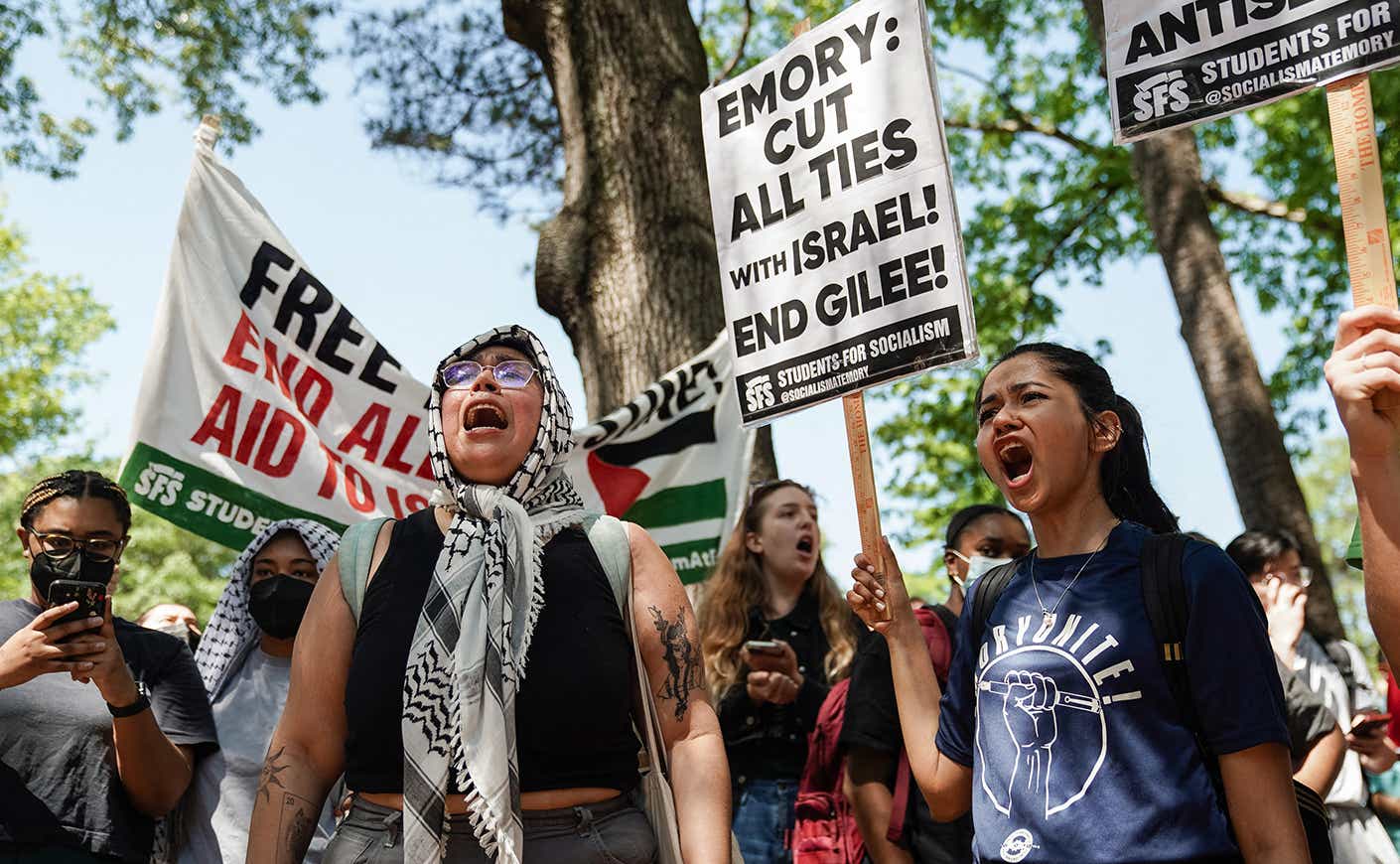Student protests over the Israel-Hamas war show no signs of stopping, despite police crackdowns. More than 200 protesters were arrested on Saturday at Northeastern University, Arizona State University, Indiana University, and Washington University in St. Louis. In total, more than 800 demonstrators on campuses nationwide have been arrested since a police raid on a Columbia University encampment on April 18th.
Some responses have been more violent than others — last Thursday, Georgia officers reportedly fired rubber bullets and tear gas into a crowd of protesters at Emory University in Georgia. Then later that day, police at Ohio State University also confirmed that they made 36 arrests at a pro-Palestine rally. Both of these frenzied scenes came a day after University of Texas at Austin dispatched state troopers to respond to a pro-Palestinian protest on campus — there were at least 57 arrests, though all were later released.
Not all schools are calling for law enforcement to take action: The University of California at Berkeley has had similar demonstrations over the war in Gaza but officials there have backed off and sought to deescalate tensions.
While it’s too soon to tell just how big these demonstrations might get before classes let out for the summer, historians like New York University professor Robert Cohen have told Vox that the movement be “the largest student movement so far.” But just how much do they differ from the ones in the past? Here’s a closer look.
How today’s protests are similar (and different) from past campus protests
As encampments pop up campuses across the country, some see parallels between today’s demonstrations and previous ones in history. Protests over the Vietnam War throughout the 1960s and 1970s saw similar clashes with authorities and mass arrests by the hundreds.
The difference is students today are using largely calm and non-violent tactics, including sit-ins. “We’re not seeing, as we did in the 1960s, rioting, rocks being thrown at police, even buildings getting burned — being burned down,” historian at the City University of New York Angus Johnston told PBS. “The protests themselves have been pretty moderate.” But this hasn’t been the case everywhere — Emory University President Gregor Fenves said in a statement that on April 25, some protesters pinned police against doors and threw objects at them as they tried to gain access into the Candler School of Theology.
What has appeared to inflame the situation is the presence of law enforcement, which has arrested students and faculty alike. As professors rally alongside students at demonstrations, some have been taken into custody— including Noelle McAfee, the philosophy department chair at Emory University.
What are students demanding?
Their demands vary from campus to campus. But what students are primarily looking for is a divestment of the universities’ alleged financial relationships with Israeli companies and its military — or at the very least, some transparency on these connections if they exist.
It’s worth noting that this has been achieved in the past. Anti-apartheid protesters in the 1980s made a similar demand to their universities, and at least 155 colleges divested from firms that profited or supported apartheid in South Africa. Then in 1986, the federal government enacted a larger divestment policy, and Congress passed a series of economic sanctions against the South African government. While this movement wasn’t the only reason why apartheid ended, it was a key contributing factor.
But it would be difficult — if not impossible — to ban imports from Israel, because many of them, like computer technologies and medical devices, don’t have substitutes. Some academics have questioned whether such divestment is possible nowadays as school funding comes under fire and donations at many top universities have dropped.
“The context today is very different than in the 1960s or 1970s when higher education was growing and the federal and state investments in higher education were increasing,” University of Texas history professor Steven Mintz told PBS. “Today, the situation of American higher education is extremely precarious.”
There’s also a major divide over the war in Gaza, especially among younger and older generations. According to a poll from the nonpartisan Pew Research Center, one-third of Americans under the age of 30 sympathize more with the Palestinian people, while 14 percent say their sympathies lie with Israelis. By comparison, 47 percent of adults 65 and older had more sympathy for Israelis, compared to just 9 percent who felt the same about Palestinians.
What’s at stake for students speaking out?
Students who participated in the pro-Palestine protests are facing some serious concerns about their academic futures. For instance, some students at Columbia University who were arrested were banned from campus altogether, including attending virtual classes.
Barnard, a college of Columbia University, suspended more than 50 students who were arrested and evicted them from campus housing. According to the AP, one student only had 15 minutes to gather all of her things before moving out.
Other students are worried about whether they’ll be allowed to take their final exams, receive financial aid, or even graduate. Schools like Columbia and Yale have said these outcomes will depend on disciplinary hearings, which for the most part remain TBD.
In light of this, some faculty members have spoken out. In an open letter to Vanderbilt University Chancellor Daniel Diermeier, more than 150 professors criticized the school’s response to the protests as “excessive and punitive.”
While it’s unclear how the protesters and administrators will come to an agreement, the latest campus protests have raised important questions about how colleges should (or shouldn’t) balance free speech and campus safety.









